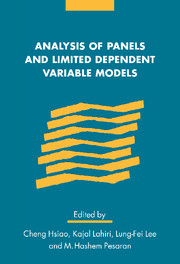Book contents
- Frontmatter
- Contents
- List of contributors
- Foreword
- Introduction
- 1 A note on left censoring
- 2 Autoregressive models with sample selectivity for panel data
- 3 Mixture of normals probit models
- 4 Estimation of dynamic limited-dependent rational expectations models
- 5 A Monte Carlo study of EC estimation in panel data models with limited dependent variables and heterogeneity
- 6 Properties of alternative estimators of dynamic panel models: an empirical analysis of cross-country data for the study of economic growth
- 7 Modified generalized instrumental variables estimation of panel data models with strictly exogenous instrumental variables
- 8 Expectations of expansions for estimators in a dynamic panel data model: some results for weakly exogenous regressors
- 9 Re-examining the rational expectations hypothesis using panel data on multi-period forecasts
- 10 Prediction from the regression model with one-way error components
- 11 Bayes estimation of short-run coefficients in dynamic panel data models
- 12 Bias reduction in estimating long-run relationships from dynamic heterogeneous panels
- CV of G.S. Maddala
- Index
4 - Estimation of dynamic limited-dependent rational expectations models
Published online by Cambridge University Press: 22 September 2009
- Frontmatter
- Contents
- List of contributors
- Foreword
- Introduction
- 1 A note on left censoring
- 2 Autoregressive models with sample selectivity for panel data
- 3 Mixture of normals probit models
- 4 Estimation of dynamic limited-dependent rational expectations models
- 5 A Monte Carlo study of EC estimation in panel data models with limited dependent variables and heterogeneity
- 6 Properties of alternative estimators of dynamic panel models: an empirical analysis of cross-country data for the study of economic growth
- 7 Modified generalized instrumental variables estimation of panel data models with strictly exogenous instrumental variables
- 8 Expectations of expansions for estimators in a dynamic panel data model: some results for weakly exogenous regressors
- 9 Re-examining the rational expectations hypothesis using panel data on multi-period forecasts
- 10 Prediction from the regression model with one-way error components
- 11 Bayes estimation of short-run coefficients in dynamic panel data models
- 12 Bias reduction in estimating long-run relationships from dynamic heterogeneous panels
- CV of G.S. Maddala
- Index
Summary
Introduction
The problem of rational expectations (RE) in limited dependent variable (LDV) models was first considered in Chanda and Maddala (1983). Maddala (1993) provided more detailed discussions on expectation formation under different assumptions used by agents as well as different estimation methods. The specification and estimation of such models have further been investigated in Maddala (1990, 1993), Pesaran (1990), Donald and Maddala (1992), Lee (1994), Pesaran and Ruge-Murcia (1996, 1998), and Pesaran and Samiei (1995). Under some general conditions, the RE solution exists and is unique (Pesaran and Samiei (1992a), Donald and Maddala (1992), Lee (1994), and Pesaran and Ruge-Murcia (1996)). The usefulness of such models in empirical studies can be found in Shonkwiler and Maddala (1985) and Holt and Johnson (1989) for agricultural commodities markets with price supports and Pesaran and Samiei (1992a, 1992b) and Edin and Vredin (1993) for models with exchange rate determination under a target zone.
For the estimation of limited-dependent rational expectations (LDRE) models, Pesaran and Samiei (1992a) have suggested the maximum likelihood (ML) method. Estimated models have, so far, assumed serially independent disturbances. Even though dynamics can easily be introduced through the inclusion of observed lagged dependent variables without complication (Pesaran and Samiei (1992b)), neither dynamic structures involving lagged latent dependent variables nor serially correlated disturbances are allowed. As these models are used for time series data, it is of interest to consider the model estimates with serial correlation or latent dynamic structures in addition to the inclusion of observed lagged dependent variables.
- Type
- Chapter
- Information
- Analysis of Panels and Limited Dependent Variable Models , pp. 79 - 113Publisher: Cambridge University PressPrint publication year: 1999



